6 Best Ways to Relieve Neck Pain From Sleeping Wrong
Have you ever woken up to find your neck too painful that you can’t even nod?
Neck pain from sleeping wrong can ruin an otherwise beautiful day. Believe me–I’ve been there.
When I was still a student neck deep in deadlines (no pun intended), I usually dozed off when no amount of caffeine couldn’t keep me awake any longer. And sleep I did–even in the most awkward positions.
Unfortunately, it’s always my neck that suffers all the consequences. If it’s any consolation, the experience has taught me effective ways to cope with it and prevent the pain from affecting my life.
You may say neck pain from sleeping wrong is part and parcel of a busy, sleep-deprived life but it doesn’t have to be that way. In this guide, I’ll be sharing with you some of the best ways to cure neck pain from sleeping wrong and prevent it from coming back.
Can you really get neck pain from sleeping in the wrong position?
Bad posture is bad for your health regardless if you’re sitting in a chair or sleeping.
The problem with the latter is you’re too deep in sleep to realize that your neck is in an awkward position. As a result, you’re locked in the same position for hours and never notice it until it’s too late.
Sleep-related neck pain may be caused by a lot of factors but it all boils down to one thing: your neck spine is out of alignment.
Remember, the spine should be kept in a neutral position, meaning the cervical spine (i.e., neck spine) shouldn’t bend higher or lower than the rest of the spine.
Otherwise, the wrong alignment causes strain to the muscles and ligaments supporting your neck.
It’s the same injury you get when you hunch over your computer for hours on end: Not only will you experience neck pain and stiffness, but also headaches and arm pain that can ultimately cause more sleep disturbance.
How long does neck pain from sleeping wrong last?
Unless you don’t suffer from an underlying medical condition, neck pain from sleeping wrong usually subsides after a few weeks.
On average, the pain and stiffness should be gone within 2 weeks. For some, total recovery may be achieved after 4 to 6 weeks.
During this time, you should avoid activities or sports that put your safety at risk simply because you’re unable to move your neck (e.g., driving and cycling).
How to relieve neck pain from sleeping wrong: 5 quick remedies.
The following techniques will help you heal and subsequently prevent neck pain from sleeping in an awkward position. Should the symptoms persist after days or weeks of treatment, visit your doctor to have a thorough examination.
Heat or cold packs.

Heat and cold applications are applied as first-aid treatments to neck pain.
Whereas ice applications reduce the swelling and soreness of the affected muscles, heat packs can provide pain relief especially for those who have aversion or intolerance to ice.
For cold applications, you can use any one of the following:
- Frozen ice in a paper cup with the upper edge of the cup removed for easier application.
- Bag of ice.
- Bag of frozen peas.
- Frozen towel.
Apply the ice pack to the sore area, preferably 15 to 20 minutes three or more times a day. If your skin is sensitive to cold, you can wrap the ice pack in a thin dry cloth before applying it. Be careful not to overdo it, especially if you have poor skin sensation.
As for the heat application, you can try any one of the following:
- Hot bath.
- Hot shower.
- Moist towel heated in a microwave.
Just like in the ice application, heat should be applied for not more than 15 minutes several times a day. Avoid prolonged application or overheating, especially if you have poor skin sensation that causes you to misjudge the temperature.
Neck massage.
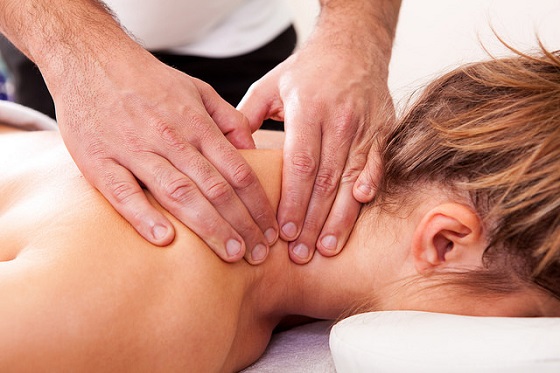
Massage provides quick relief for muscle tension and stiffness by stimulating blood circulation. Ideally, you should pay a licensed therapist to do the massage since the neck is a delicate part that may not tolerate excessive pressure.
A typical neck massage is done by applying gentle finger pressure to both sides of the neck all the way down to the upper back. Heat or ice application is usually given prior to the massage so the muscles will have less spasm and won’t be painful to the touch.
Of course, you can’t always rely on a massage therapist or another person to give you neck massage when you badly need it.
If you prefer a more convenient and cheaper way to get a quick massage anywhere or anytime you want, you should try one of these electric neck massagers.
With a neck massager, you no longer need to apply heat packs prior to massage since it has a built-in heat option and automatic massage of varying intensities, all of which can be activated at a click of a button.
Over-the-counter painkillers.

The thing with mild to moderate neck pain is it only gets worse if you completely restrict neck movements. Unless its a neck injury sustained from an accident, it’s not advisable to wear neck collars.
Rather, you should stay active and still perform neck stretches as you usually do. Exercise strengthens muscles, speeds up recovery, and prevents similar injuries in the future.
But how can you perform daily tasks, let alone neck exercises, if your neck muscles are to stiff and screaming pain?
The answer is by taking the recommended dose of painkillers like ibuprofen and paracetamol. These medications will lessen the pain so you can exercise and do your usual chores with minimal discomfort.
However, keep in mind that painkillers may have side-effects especially if taken carelessly.
As a rule of the thumb, don’t take these medications without the doctor’s approval if you’re pregnant, asthmatic, or suffering from ulcers or indigestion.
Neck stretches and exercises.
When most people wake up with a stiff and painful neck, the usual knee-jerk reaction is to stop doing anything and let the body heal itself.
Although a little rest is ok, complete bed rest while wearing a neck collar will do more harm than good.
Assuming that the neck pain is caused by sleeping in an awkward position, restricting the neck movement with the use of a collar will cause the neck muscles to become weaker, making you vulnerable for similar injuries in the future.
In contrast, doing neck stretches or exercises that you can tolerate provide the following health benefits:
- Reduced neck pain and stiffness.
- Improved muscle strength, stamina, and flexibility.
- Increased blood flow to injured muscles which contribute to faster recovery.
The Arthritis Research UK recommends four simple neck exercises you can do anywhere:
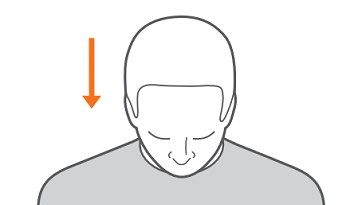
Neck tilt: Tilt your head down so your chin is resting on your chest. Hold the position for 5 seconds as you gently tense your neck muscles. Return to the neutral position and repeat it 5 times.
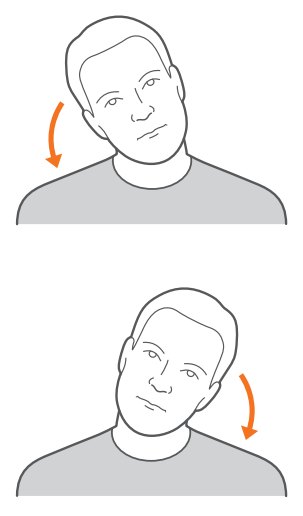
Neck tilt (side to side): Tilt your head to the side toward your shoulder. Hold for 5 seconds as you gently tense your neck muscles. Return your head to the center and repeat on the opposite side. Complete 5 repetitions for each side.
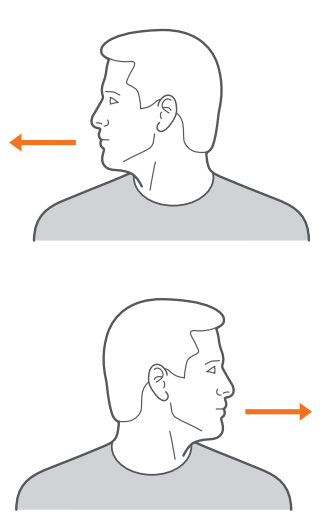
Neck turn: This one is similar to the previous exercise, except this time you keep your head straight and your chin at the same height as you turn towards one side. Hold this position for 5 seconds as you tense your neck muscles. Return to the central position and repeat on the other side. Complete 5 repetitions on each side.
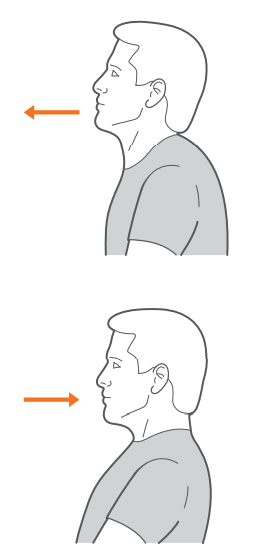
Neck stretch: Similar to how ducks move their heads, this simple exercise starts by moving your chin forward so that your throat is stretched. Hold for 5 seconds while you tense your neck muscles. Return to the center and then move your head backward, keeping your chin up. Hold for 5 seconds and then repeat the exercise 5 times.
Ideal sleeping positions.
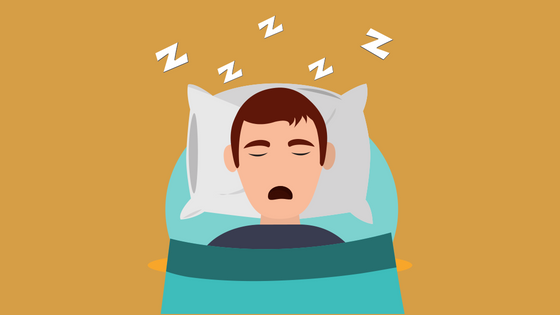
Your sleeping position can be a result of a deeply ingrained habit. Or, it’s simply because you’re too exhausted upon lying on the bed to even think about how your body is positioned.
Either way, it’s never too late to stick to a proper sleeping posture if you want to get rid of the neck pain for good.
Sleeping on your stomach, for instance, guarantees a neck pain the morning after because your back is arched and your neck is turned to the side.
In order to prevent sleep-related neck pain, your cervical spine (i.e., neck spine) must be in neutral alignment with the rest of the spine.
Hence, you should sleep either on your back or side with a pillow keeping your neck in a neutral position. You can also place a pillow behind your knees when sleeping on your back to flatten the spine further and relax the neck muscles.
Otherwise, an awkward position–meaning your neck is angled either upward or downward–will impose a load on your neck muscles resulting to pain and stiffness.
Even though you may habitually find yourself sleeping on your stomach, being aware that this isn’t good for your neck will prompt you to change position and stick to a better sleeping posture in the long run.
Sleeping pillows.
The pillow you sleep on is just as important as your sleeping position. After all, you can’t keep your neck in a neutral position if your pillow isn’t designed to keep it that way.

As shown in the picture above, neck pain from sleeping wrong isn’t entirely caused by an awkward sleeping position. An ideal pillow (1) should fit between your ear and shoulder (if you’re a side-sleeper) without moving your neck.
On the other hand, a pillow that is either too high (2) or too low (3) can put your neck spine out of alignment eventually leading to neck pain and stiffness.
Harvard Health recommends using a pillow with a flatter portion for your head and a rounded or more elevated edge to support the natural curve of your neck.
The built-in neck support should cushion your neck muscles while keeping them in a neutral position.
You can easily find these pillows in the market, with some companies offering feather or “memory foam” pillows that conform to the shape or contour of the user’s head and neck.
For those who travel frequently, horseshoe-shaped cervical pillows are designed to keep your head from dropping while you’re sleeping in the car, plane, or train. Make sure to choose a pillow that is neither too small nor too large behind the neck. Otherwise, it will push your head forward and throw your neck out of alignment.
When should I go to the doctor?
Neck pain from sleeping wrong usually subsides after a few weeks of taking painkillers. If you’ve tried all of the suggestions above and the neck pain persists or worsens, contact your physician.
Immediate medical care must be given if your neck pain has become severe and is accompanied by other symptoms like a headache, numbness or tingling sensation on one or both arms, and weakness.
References
Isaac, Z. Patient education: Neck pain (Beyond the Basics). Retrieved from https://www.uptodate.com/contents/neck-pain-beyond-the-basics
Neck pain. Retrieved from https://www.nhs.uk/conditions/neck-pain-and-stiff-neck/
Neck pain exercises. (2012). Retrieved from https://www.csp.org.uk/publications/neck-pain-exercises
Say “good night” to neck pain. Retrieved from https://www.health.harvard.edu/pain/say-good-night-to-neck-pain




